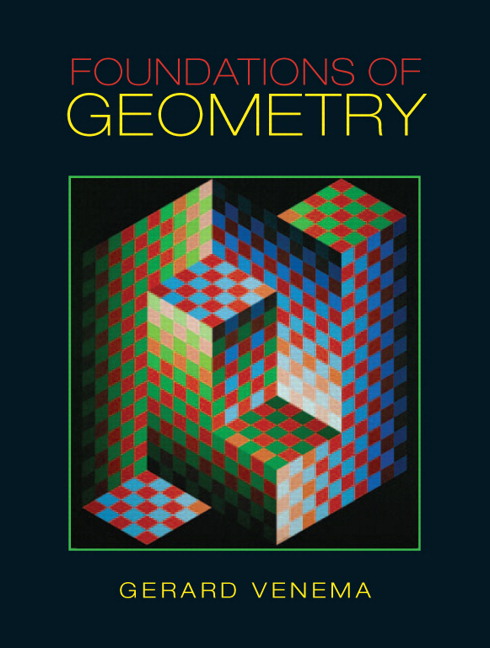THE FOUNDATIONS OF GEOMETRY is a textbook for an undergraduate course in
axiomatic geometry. The course is suitable for all mathematics majors, including those who plan to
become high school mathematics teachers. The textbook implements the recent recommendations
regarding "The Mathematical Education of Teachers" within the context of a traditional
axiomatic treatment of geometry. In addition to all the standard topics (Euclid's Elements,
axiomatic systems, the parallel postulates, neutral geometry, Euclidean geometry, hyperbolic geometry,
constructions, transformations, and the classical models for non-Euclidean geometry), the book also
includes a chapter on polygonal models for the hyperbolic plane and the geometry of space.
Basic information about the book
|
|

|
|
Title: THE FOUNDATIONS OF GEOMETRY
Author: Gerard A. Venema
ISBN: 0-13-143700-3
Publisher: Prentice Hall (now Pearson)
Publication date: January, 2005
Copyright: 2006
Format: Paper; 448 pp
List price: $84.00
More information about the book is available in the
Prentice Hall catalog. If you wish to obtain a copy, you can either order one
directly from the
publisher or from a bookseller such as
Amazon.com. The cover art is by Victor Vasarely,
Hungarian-born French abstract painter, 1908-1997.
|
Second Edition published by Pearson
The second edition of the book was published by Pearson Education, Inc., in 2012. Click on the link below for information on the second edition.
Technology Supplement published by MAA
A supplement entitled Exploring Advanced Euclidean Geometry with GeoGebra was published by
the Mathematical Association of America (MAA) in 2013. This book can be used either as
a lab manual to supplement a course taught from The Foundations of Geometry, Second Edition
or as a stand-alone introduction to advanced topics in Euclidean geometry.
The book utilizes dynamic geometry software, specifically GeoGebra, to explore the statements and proofs of many of the most interesting theorems in advanced Euclidean
geometry. The text begins with a short but complete introduction to GeoGebra; the
remainder of the text consists almost entirely of exercises that guide students as they discover the
mathematics and then come to understand it for themselves. It covers such topics as triangle centers, circumscribed and inscribed circles,
medial and orthic triangles, the nine-point circle, the theorems of Ceva and Menelaus, and
many applications of the theorems of Menelaus and Ceva. It also includes
chapters on Euclidean inversions and the Poincaré disk.
Click on the link below to learn more.
Additional items available at this time
Errata
A third printing of the book is available as of May, 2007. The first two printings
contained a number of minor typographical errors that have been corrected.
If you should discover an error in the third printing or an uncorrected error in an earlier printing
of the book, please notify Gerard Venema
(venema@calvin.edu). Any error that is brought to my
attention will be corrected in the next printing.
